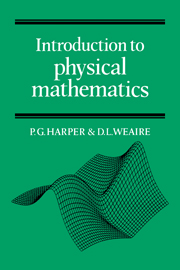Book contents
- Frontmatter
- Contents
- Preface
- Some notes on notation
- 1 Introduction
- 2 Errors
- 3 Cartesian coordinates
- 4 Vectors
- 5 The scalar product
- 6 The vector product and rotation
- 7 Matrices in physics
- 8 The transformation of matrices
- 9 The matrix eigenvalue equation
- 10 Exponential and logarithm functions
- 11 Sine and cosine functions
- 12 Graph plotting and curve sketching
- 13 Differentiation
- 14 Approximations
- 15 Power series and Taylor's expansion
- 16 Partial differentiation
- 17 Integration
- 18 The differential equation
- 19 Solving first-order differential equations
- 20 Second-order differential equations
- 21 Solving second-order differential equations
- 22 The complex exponential
- 23 The circuit equation
- 24 Harmonics and Fourier series
- 25 The diffusion equation
- 26 Waves
- 27 The rate of change of a vector
- 28 The scalar field and gradient operator
- 29 The vector field
- 30 Line integration
- 31 The potential field
- 32 Surface and volume integration
- 33 Flux and divergence
- 34 Circulation and the curl
- 35 Conclusion
- 36 Miscellaneous exercises
- Index
6 - The vector product and rotation
Published online by Cambridge University Press: 20 October 2009
- Frontmatter
- Contents
- Preface
- Some notes on notation
- 1 Introduction
- 2 Errors
- 3 Cartesian coordinates
- 4 Vectors
- 5 The scalar product
- 6 The vector product and rotation
- 7 Matrices in physics
- 8 The transformation of matrices
- 9 The matrix eigenvalue equation
- 10 Exponential and logarithm functions
- 11 Sine and cosine functions
- 12 Graph plotting and curve sketching
- 13 Differentiation
- 14 Approximations
- 15 Power series and Taylor's expansion
- 16 Partial differentiation
- 17 Integration
- 18 The differential equation
- 19 Solving first-order differential equations
- 20 Second-order differential equations
- 21 Solving second-order differential equations
- 22 The complex exponential
- 23 The circuit equation
- 24 Harmonics and Fourier series
- 25 The diffusion equation
- 26 Waves
- 27 The rate of change of a vector
- 28 The scalar field and gradient operator
- 29 The vector field
- 30 Line integration
- 31 The potential field
- 32 Surface and volume integration
- 33 Flux and divergence
- 34 Circulation and the curl
- 35 Conclusion
- 36 Miscellaneous exercises
- Index
Summary
The movement of a solid object by a force is practical dynamics in action. Consider for example a ship's anchor being dragged by its cable and digging into the sea-bed. How does the anchor move, and in response to what forces? There is the tension in the cable, the reaction and resistance of the sea-bed material, the weight of the anchor, and so on. (One of the authors can claim some expertise in this matter, having been involved in a court case which centred upon it.) The forces are vectors (chapter 4) – they can be resolved in any convenient direction, and they can be added according to the vector rule to give a resultant. There is a theorem of dynamics which states that the centre of mass of the anchor moves in response to this force, as if all the mass of the anchor were concentrated there. But the various forces act at different points. The cable tension acts at the end of the shank, the soil/sand reaction at the fluke-centre, and so on. Accordingly, they can also rotate the anchor.
What is the appropriate combination of forces with which to consider this aspect of the problem? The answer is the total torque or moment of the forces about some chosen point. Another theorem of dynamics prescribes the rotational motion of the body about the point, in response to the torque.
- Type
- Chapter
- Information
- Introduction to Physical Mathematics , pp. 35 - 42Publisher: Cambridge University PressPrint publication year: 1985

